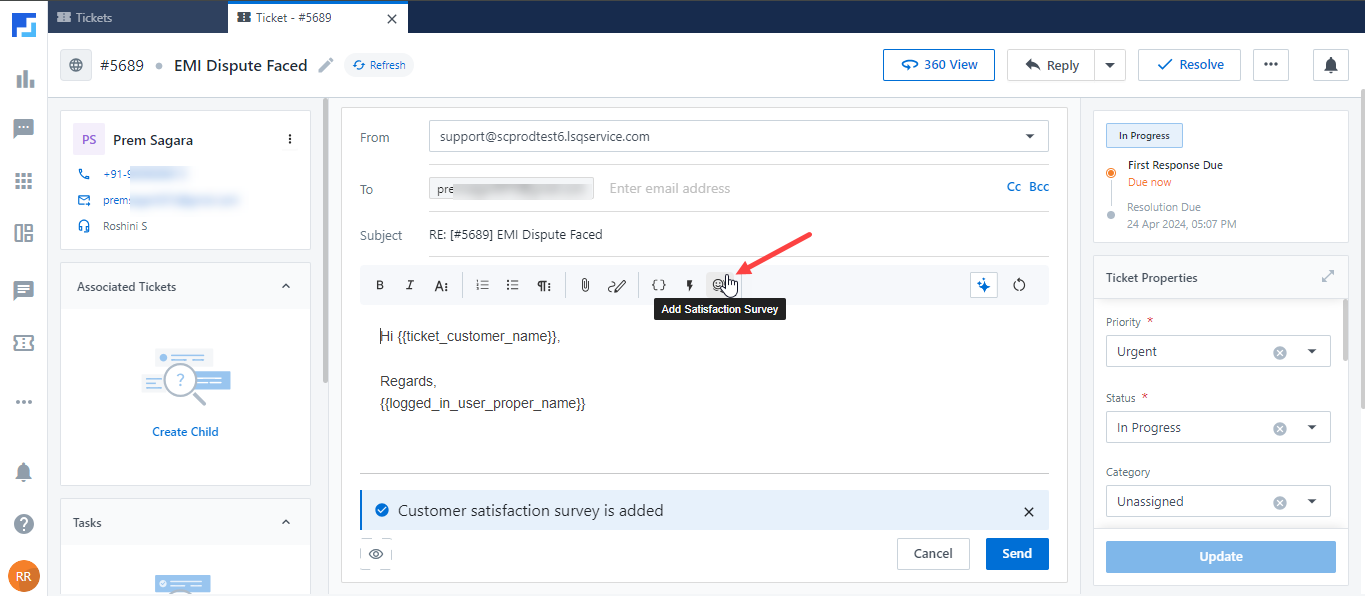Are you really listening to what your customers are telling you? How can a simple metric like a customer satisfaction score (CSAT) change how you do business? Most importantly, are you using this data to drive real change and improve your business?
In this article, we’ll discuss CSAT scores, how to measure and analyze them, and how to use them to not only meet but beat customer expectations. By the end, you’ll have a clear plan for using customer satisfaction as a key driver of long-term success and customer loyalty.
What is a Customer Satisfaction Score?
A Customer Satisfaction Score (CSAT) measures the degree to which a customer is satisfied with a product, service, or interaction with a company.
It’s usually measured through surveys that ask customers to rate their satisfaction on a scale, often 1 to 5 or 1 to 10.
Here’s an example of a CSAT question:
“How satisfied were you with your experience today?” The answer can be on a scale of 1-5
- Scores 1,2 and 3 mean the customer was not satisfied and the service needs to improve
- Scores 4 and 5 mean the customer enjoyed their experience
The CSAT score is then calculated by taking the percentage of customers who selected 4 or 5 (or the top two options on whatever scale you’re using).

For example, if 75 out of 100 customers rated their satisfaction as 4 or 5, your CSAT score would be 75%
But why does this score number matter so much? Let’s get into it.
Why Customer Satisfaction Scores Matter
Customer satisfaction scores are more than just numbers – they’re an overview of your business and a predictor of future success. Here’s why they’re so important:
Loyalty
Happy customers are loyal customers. A high CSAT score means your customers will stick around, reduce churn, and increase lifetime value. According to a study in Harvard Business Review, increasing customer retention by just 5% can increase profits by 25% to 95%.
Word-of-mouth marketing
Happy customers are your best marketers. They’ll recommend your product or service to others and drive organic growth. A report by Nielsen found that 92% of consumers trust recommendations from friends and family over all forms of advertising.
Areas for improvement
Low scores in certain areas will show you where your business needs to focus on improvement. This is where a robust service CRM like LeadSquared can come in handy to track and analyze customer feedback across all touchpoints.
Competitive edge
In a world where products and services are getting commoditized, customer satisfaction can be the differentiator. A PwC survey found 73% of consumers consider customer experience as an important factor in their purchasing decisions.
Financial impact
There’s a direct link between customer satisfaction and financial performance. A study in the Journal of Marketing found companies with high CSAT scores outperform the market with higher stock returns and better cash flows.
“Customer satisfaction is worthless. Customer loyalty is priceless.”
– Jeffrey Gitomer
This quote sums it up nicely: while satisfaction is important, the real business driver is the loyalty it creates. CSAT scores are the first step in measuring and building that loyalty.
Now that we know what CSAT scores are and why they matter, let’s examine how to measure and improve them.
How to Measure Customer Satisfaction Scores
Measuring CSAT scores is more than just sending out a survey. Here’s a step-by-step guide to help you get it right:
Ask the right question
The wording of your CSAT question can affect the responses you get. Keep it simple, clear, and specific to the interaction or product you’re measuring.
Choose the right scale
5-point and 10-point scales are common but choose the scale that makes sense for your business and customers.
Ask at the right time
Timing is everything. Ask too soon and customers might not have had enough time to form an opinion. Ask too late, and their memory of the experience might fade.
Use multiple channels
Don’t rely on a single way to collect CSAT data. Use email surveys, in-app questionnaires, and post-interaction pop-ups to get a wider range of responses. LeadSquared CRM can help you automate this across multiple channels so you can capture feedback at every customer touchpoint.

Keep it short
Don’t waste your customers’ time. Keep your surveys brief and focused on the most important parts of their experience.
Analyse and act
Measuring CSAT scores is just the start. The real value comes from analyzing the data and using it to drive improvements in your business. LeadSquared’s analytics tools can help you extract insights from your CSAT data to make data-driven decisions to improve customer satisfaction.
Best Practices to Improve Your CSAT Scores
Now that you’re measuring your CSAT scores correctly, how can you improve them?
Respond to feedback fast
When customers take the time to provide feedback, especially negative feedback, responding quickly shows you value their input and are committed to fixing the issue. A Zendesk study found 89% of customers are more likely to buy again after a quick customer service experience.
Empower your frontline staff
Your front-line staff is key to satisfaction. Give them the training, tools, and authority to resolve issues. LeadSquared CRM can give your team a 360-degree view of each customer so they can deliver personal and effective service.
Personalize the customer experience
Use the data you collect to customize your interactions and offers to individual customer preferences and needs. A 2023 Epsilon study found 80% of consumers are more likely to buy when brands offer personalized experiences.
Set and manage expectations
Clear communication about what customers can expect from your product or service can prevent disappointment and increase satisfaction.
Continuously improve your product/service
Use CSAT data to identify where your product or service is falling short and prioritize improvements accordingly. LeadSquared’s analytics can help you spot trends and patterns in your CSAT data to guide your product development.
Create a customer-centric culture
Make customer satisfaction a core value in your business. Get all employees, not just those in customer-facing roles, to think about the impact of their work on the customers.
Let’s look at a real-life example of how focusing on customer satisfaction can drive business results:
Zappos, the online shoe and clothing retailer, is famous for its customer satisfaction. They’ve built their entire business around delivering amazing customer experiences with initiatives like:
- 365-day return policy
- Free shipping both ways
- 24/7 customer service
- Empowering customer service reps to do whatever it takes to make customers happy
The result? Zappos gets CSAT scores above 90% and has grown from a startup to a billion-dollar business largely through word of mouth, driven by happy customers.
This is what happens when you focus on customer satisfaction. With LeadSquared Service CRM, you can implement similar customer-centric strategies in your business and track and improve customer satisfaction at every stage of the journey.
CSAT vs Other Metrics
While CSAT is a great metric in its own right, it’s even more powerful when considered with other KPIs. Here’s how CSAT relates to other metrics:
Net Promoter Score (NPS)
NPS measures customer loyalty by asking how likely customers are to recommend your product or service. CSAT gives you a snapshot of satisfaction with a specific interaction, NPS gives you a broader view of overall loyalty. A 2023 Temkin Group study found companies with high NPS scores have CSAT scores 30% higher than their competitors.
Customer Effort Score (CES)
CES measures how easy it is for customers to get their issues resolved or complete desired actions. Low effort often correlates with high satisfaction so CES is a great complement to CSAT. LeadSquared CRM can help you track both CSAT and CES to get a full view of your customer experience.
Churn rate
Churn rate is the percentage of customers who stop using your product or service over a given period. There’s often an inverse relationship between CSAT and churn – as satisfaction increases, churn decreases. LeadSquared’s analytics can help you identify at-risk customers before they churn so you can take proactive measures to increase their satisfaction.
Revenue growth
Ultimately the goal of improving customer satisfaction is to drive business growth. Tracking the correlation between your CSAT scores and revenue will help you measure the ROI of your customer satisfaction efforts.
By considering CSAT with these other metrics, you can get a full view of your customer relationships and their impact on your business. LeadSquared CRM has dashboards that allow you to track all these metrics in one place so you can spot correlations and trends.
The Future of CSAT Measurement
As we look ahead several trends are emerging in customer satisfaction measurement:
AI and machine learning
Artificial intelligence and machine learning are being used to analyse customer feedback at scale, to identify patterns and insights that might be missed by human analysis alone. A 2023 Gartner report predicts by 2025 60% of organisations will use AI for sentiment analysis to improve product and service quality.
Real-time feedback
With the rise of IoT devices and always-on connectivity, businesses are moving towards real-time satisfaction measurement so they can respond to customer issues in real time.
Omnichannel measurement
As customer interactions span multiple channels, CSAT measurement is evolving to provide a full view of satisfaction across all touchpoints. A Harvard Business Review study found companies with strong omnichannel customer engagement retain 89% of their customers compared to 33% for companies with weak omnichannel engagement. LeadSquared offers omnichannel communication that simplifies customer communication and boosts efficiency.
Emotion Analytics
Beyond measuring satisfaction, businesses are using technology to measure customer emotions during interactions to get a deeper understanding of the customer experience.
These trends will make CSAT measurement even more powerful in the future. With LeadSquared CRM you can get ahead of these trends and use the latest technology to improve your customer satisfaction efforts continually.
Conclusion
As we’ve seen above customer satisfaction scores are more than just numbers – they’re a powerful tool to understand your customers, improve your business and drive growth. By measuring, analysing and acting on CSAT data you can create a cycle of improvement that benefits both your customers and your bottom line.
Remember at the end of the day focusing on customer satisfaction is about putting your customers first. It’s about listening to their needs, addressing their concerns and continually trying to exceed their expectations. By doing so you’ll not only improve your CSAT scores but build the kind of loyal, enthusiastic customer base that will take your business to new heights.
So go ahead and make this your mantra, using CSAT scores to build a customer-centric business that will last. With LeadSquared’s Service CRM, you have the tool to make it happen, measure customer satisfaction, and improve it every step of the way.









